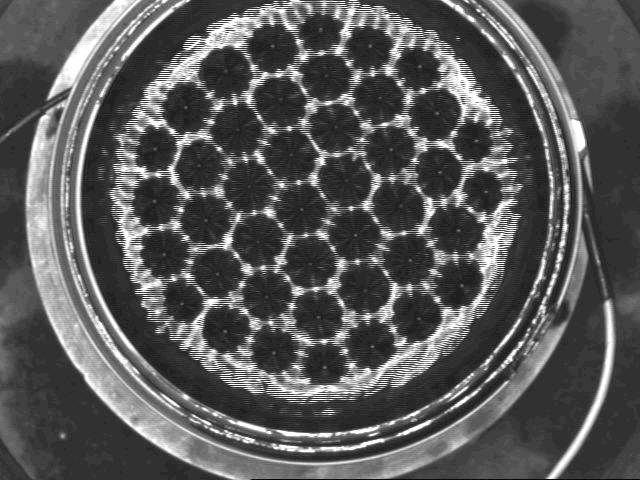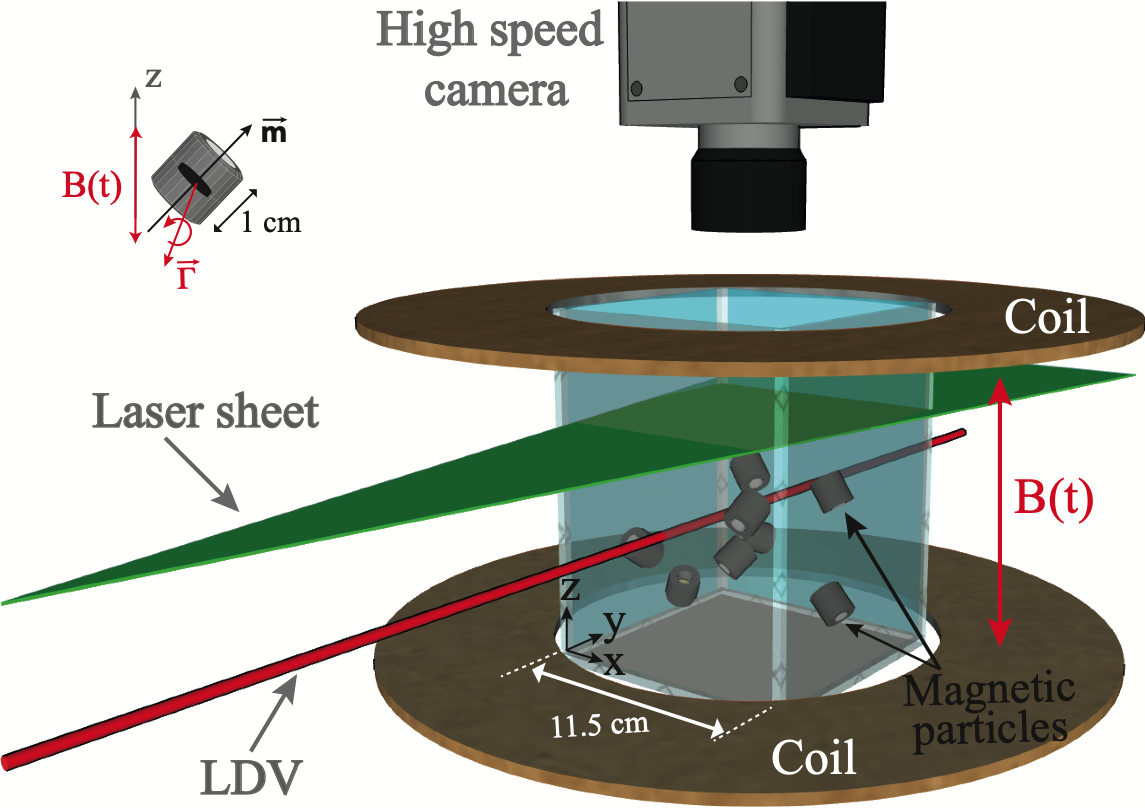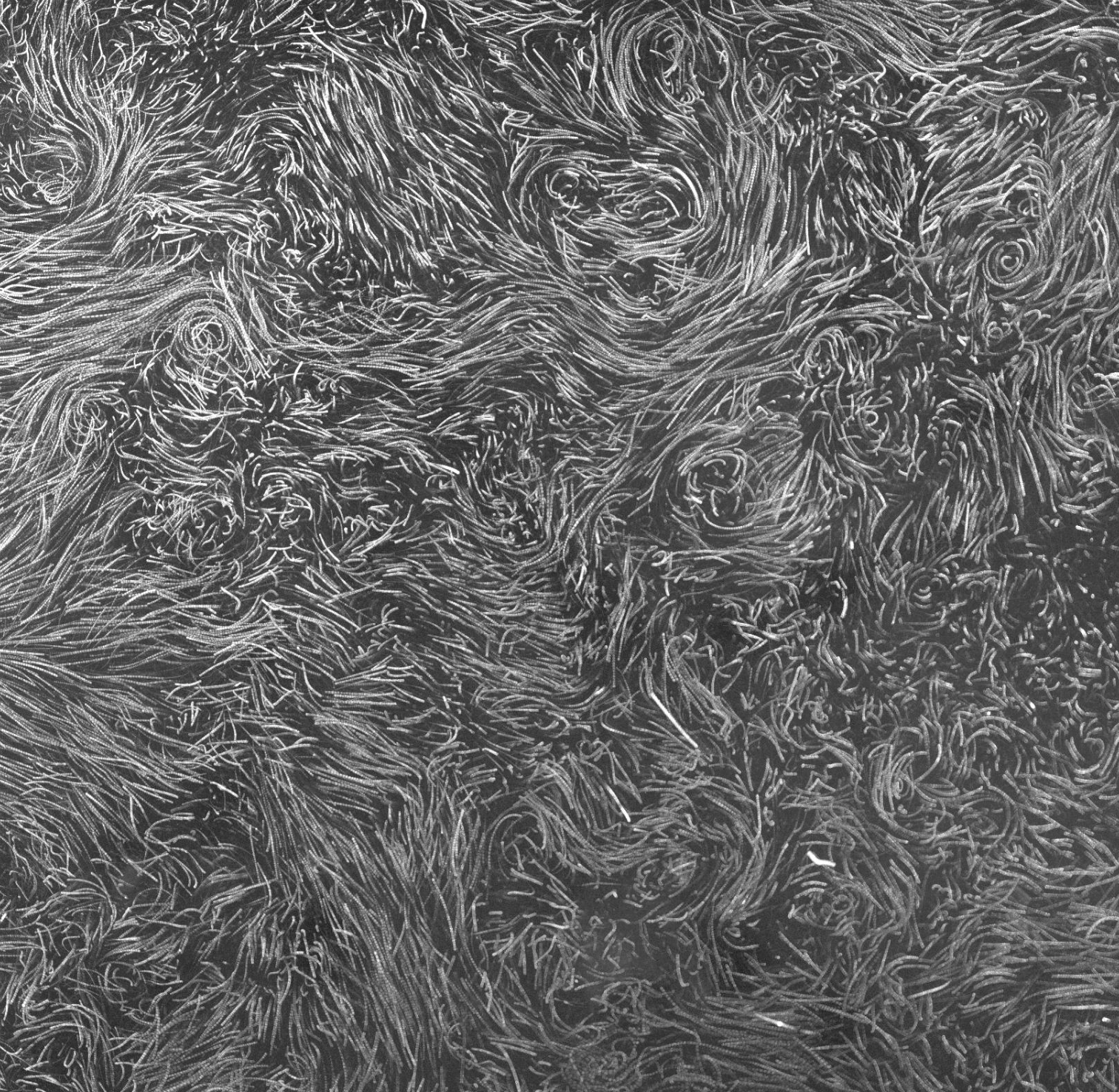 |
|
3D
HYDRODYNAMIC TURBULENCE (papers by our
group)
Such a forcing, closer to those of direct numerical simulations, generate an excellent stationary, homogeneous and isotropic turbulence with almost no mean flow, as characterized by local and spatiotemporal fluid velocity measurements [4]. We also estimate the energy dissipation rate consistently in five different ways, a situation difficult to obtain experimentally otherwise [3]. Moreover, we confirm experimentally the prediction of Tennekes for 3D turbulence without mean flow, and we resolve the disagreement between previously suggested values of the Tennekes’ constant [4].
This new technique is useful to understand the properties of large scales in 3D turbulence (i.e., scales larger than the forcing scale - see below). It could be also implemented in geophysical- or astrophysical-like turbulent flows (rotating, stratified or multiphase flows), and could provide a technological breakthrough in turbulent mixing.
 3D turbulence driven homogenously by magnetic particle (see article) |
 Fluid tracer trajectories within the PIV laser sheet over consecutive images (see article) |
Are large scales in 3D
turbulence in equilibrium?
The statistical equilibrium regime
of large scales in 3D turbulence,
predicted 70 years ago, has just been
reported experimentally for the first time
in 2022 [5].
The dynamics of turbulent flows at scales
larger than the forcing scale is a topic that
has been partially overlooked for years. Yet,
large scales control many properties of
industrial, geophysical or astrophysical 3D
turbulent flows. Most of previous experiments
and simulations on 3D turbulence had injected
energy at a scale comparable to the size of
the reservoir in order to study the turbulent
cascade towards small scales.
We have managed to perform a scale separation
between the forcing scale and the container
size [5].
We inject energy into the fluid using
centimeter-scale magnetic stirrers immersed in
a large fluid reservoir put into the gap of a
nearly one-ton electromagnet. By measuring the
statistics of the fluid velocity field, we
experimentally evidence that the large-scale
modes of 3D turbulence possess the same energy
[5].
This equipartition regime, or so-called statistical
equilibrium regime, was predicted since
1952, but had not been observed experimentally
so far. The large-scale dynamics can then be
described with an effective temperature [5].
However, this large-scale dynamic is not
isolated from the usual turbulent cascade,
called Kolmogorov cascade, which develops
towards small scales. This system is thus a
remarkable example in which interactions occur
between the degrees of freedom at equilibrium
(large scales) with out-of-equilibrium
structures (small scales) characteristic of
turbulence.
These findings pave the way to use classical
concepts (i.e., equilibrium statistical
mechanics) to describe the large scales of 3D
turbulence, with possible applications to
climate modeling and large-scale dispersion of
pollutants by turbulence. See also a recent observation of statistical equilibrium in wave turbulence by our group.
Freely decaying 3D
turbulence
Due to the inevitable mean flow in open systems as wind tunnels, current theoretical models of freely decaying 3D turbulence, such as Saffman’s model and Batchelor’s model, are difficult to test experimentally. We use a novel forcing technique, based on the erratic motions of magnetic stirrers immersed in a closed container, to produce homogeneous decaying turbulence, overcoming the previous limitations. Our experimental observations robustly support the Saffman’s model, while the large-scale turbulent energy spectrum conserves a self-similar scaling during the decay [7]. The connection between the Saffman invariant for freely decaying turbulent flows, and the large-scale behavior of their energy spectrum is also experimentally evidenced, for the first time [7].
 |
-
In water:
8. T. Jamin, M. Berhanu, and E. Falcon 2025
Physical Review Fluids 10, 034608 (2025)
Experimental study of three-dimensional turbulence under a free surface
7. J.-B. Gorce and E. Falcon 2024
Physical Review Letters 132, 264001 (2024)
Freely Decaying Saffman Turbulence Experimentally Generated by Magnetic Stirrers
6. J.-B. Gorce and E. Falcon, 2023
Physical Review E 107, 034903 (2023)
Statistics of a two-dimensional immersed granular gas magnetically forced in volume
- 5.
J.-B. Gorce and E. Falcon, 2022
Physical Review Letters 129, 054501 (2022)
Statistical Equilibrium of Large Scales in Three-Dimensional Hydrodynamic Turbulence
- 4.
A. Cazaubiel, J.-B. Gorce, J.-C. Bacri, M.
Berhanu, C. Laroche, and E. Falcon,
2021

Physical Review Fluids 6, L112601 (2021)
Three-dimensional turbulence generated homogeneously by magnetic particles
- 3. E. Falcon, J.-C. Bacri & C. Laroche, 2017
- Physical Review Fluids 2, 102601(R) (2017) - Rapid Communication Dissipated power within a turbulent flow forced homogeneously by magnetic particles
In air (granular gas):
AIP Conf. Proc. 1542, pp. 815-818 (2013)
Experimental study of a granular gas homogeneously driven by particle rotations
1. E. Falcon, J.-C. Bacri, and C. Laroche 2013
EPL (Europhysics Letters) 103, 64004 (2013)
Equation of state of a granular gas homogeneously driven by particle rotations
In water (forcing by jets):
8. T. Jamin, M. Berhanu, and E. Falcon 2024
submitted to Physical Review Fluids (2024)
Experimental study of three-dimensional turbulence under a free surface

home page
